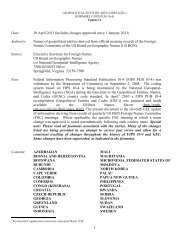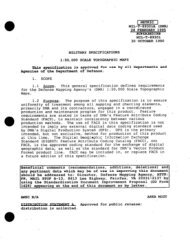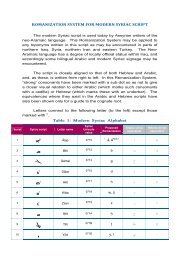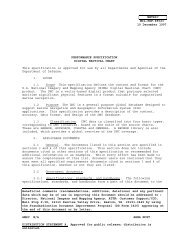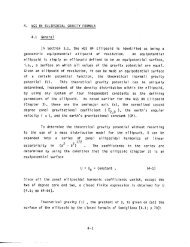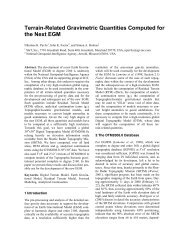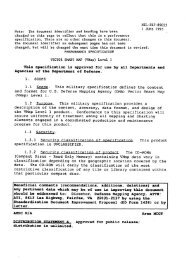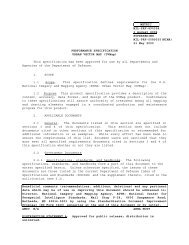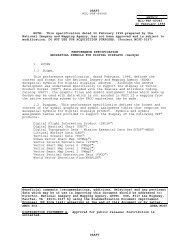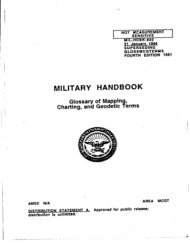ROMANIZATION SYSTEM FOR ARABIC - NGA
ROMANIZATION SYSTEM FOR ARABIC - NGA
ROMANIZATION SYSTEM FOR ARABIC - NGA
You also want an ePaper? Increase the reach of your titles
YUMPU automatically turns print PDFs into web optimized ePapers that Google loves.
NUMERALS<br />
1 2 3 4 5 6 7 8 9 0<br />
1 2 3 4 5 6 7 8 9 0<br />
Although Perso-Arabic script is written from right to left, numerical expressions, e.g., 1956 - 1956 are<br />
written from left to right.<br />
NOTES<br />
1. The symbol ◌ represents any Arabic consonant character.<br />
2. Hamzah (ء) is written in Arabic in association with most instances of initial alif, except those which<br />
belong to the definite article al or which bear a maddah (see note 11). Hamzah is written above<br />
the alif if the accompanying short vowel is a fatḩah ( َ أ) or ḑammah ( ُ أ) and below the alif if the<br />
accompanying short vowel is a kasrah (ِإ). When the purpose is to indicate the presence of a glottal<br />
stop, hamzah is written over medial and final alif (أ), wāw (ؤ) and yā’ without dots (ئ). Hamzah<br />
following kasrah (◌ِ ) is written (ئ). Almost always the yā’ is in the initial or medial form and the<br />
dots are omitted: example: (رئب). Hamzah following ḑammah (◌ُ )is written (ؤ). Hamzah following a<br />
long vowel is written without a bearer and is positioned on the line of print like a regular character.<br />
The romanization of hamzah (’) should always be carefully distinguished from that of ‘ayn (‘).<br />
3. Alif as such is not romanized when it is a bearer of hamzah, but see fatḩah alif (ا◌َ) and alif maddah<br />
( آ ) in the vowel table. See also note 2 and 11 above.<br />
4. In certain endings, an original tā’ (ت) is written (ة), i.e., like hā’ with two dots, and is known as tā<br />
marbūţah. It is romanized h, except in the construct form, where it is romanized t instead. Example:<br />
hamzah, hamzat al qaţ‘ . The ending fatḩah hā’ (ه◌َ) may be romanized a·h when the character hā’<br />
(ه) is not silent. Example: Muntaza·h. See also note 5.<br />
5. Occasionally, the character sequences ـهـكـ , ـهـتـ, ـهدـ and ـهس occur. They may be romanized k·h, t·h,<br />
d·h, and s·h in order to differentiate those romanizations from the digraphs kh, th, dh, and sh. See<br />
also note 4.<br />
6. Where special considerations are paramount, the sub-dot ( ִ ) may be used in place of the cedilla.<br />
7. The character yā’ (in final form but without dots) preceded by the vowel point fatḩah is a combination<br />
known as alif maqşūrah. See character 7 in the vowel table.<br />
8. The classical Arabic grammatical endings written with the nunation symbols (tanwīn) may be<br />
romanized, when necessary, by a n , i n , u n . In modern Arabic, these endings have become silent and<br />
should not be romanized: classical alifu n modern alif.<br />
9. Doubled consonant sounds are represented in Arabic script by placing a shaddah (◌ّ) over a<br />
consonant character. In romanization the letter should be doubled. However, the combination of<br />
the consonant character yā’ with a shaddah preceded by a kasrah (ــيِّــــ) is romanized īy rather than<br />
iyy. e.g., (ةـيِّـــ) is romanized (īyah) and not (iyyah).<br />
3



